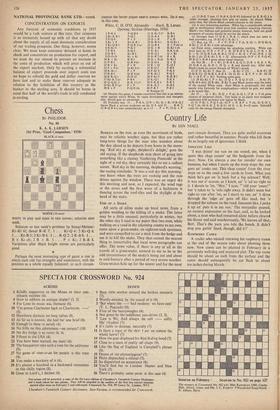Chess
K. A. K. LARSEN (1st Prize, 'Good Companions.' 1920)
BLACK (6 men,
WHITE (10 men) • WHITE to play and mate in two moves; solution next week.
Solution to last week's problem by Simay-Molnar: Kt-Kt 6!, threat R-K 7. I . . . Kt-Q 4; 2 Kt-Q 6.
1 Kt-B 3; 2 Kt-B 6. 1 . . . R-Q 2; 2 R-B 8. 1 . B x Kt ch; 2 R x B. 1 . . . P x Kt; 2 R-R 8. Variations after Black knight moves are particularly good.
Perhaps the most interesting type of game is one in which each side has strengths and weaknesses, with the position as a whole equally balanced; in such circum-
stances the better player nearly always wins. So it was. in this case.
White, C. H. O'D. Alexander Black, B. Larsen Opening, Sicilian (Hastings, 1956) 1 P-K 4 P-Q B 4 21 B-Kt 5 (1) B-B 4
2 Kt-K B 3 P-Q 3 22 R-R 4 K-B 2 3 P-Q 4 P x P 23 B x B PXB 4 Kt x P Kt-K B 3 24 R-R 6 (./ R-Q Kt 1
5 Kt-Q B 3 'P-Q R 3(a) 25 Q-R 4 R x Pch!(k
6 B-Kt 5 P-K 3 26 K x R R-Kt I ch 7 P-B 4 B-Q 2 27 K-B I B-K 6 ch
8 Q-B 3 Kt-B 3 28 R-Q 2 Q x Kt
9 0-0-0 Kt x Kt 29 R-R 7 ch B x R 10 R x Ki B-B 3 30 Q x B ch R-Kt 2 11 P-B 5 Q-R 4 (hi 31 Q-Q 4 Q X Q 12 B x Kt P x B 32R x Q K-Q 3
13 P x P (c Q-Kt 4 el 33 R-Q 2 P-B 4
14 K-Kt I P x P 34 P-Kt 4 P-K 6 15 B-B 4 Q-K 4(d) 35 R-Kt 2 P-Q 5
16 K R-Q I 0-0-0 36 P-Kt 5 R-K B 2 17 Kt-K 2 (Cl P-B 4 37 K-Q I P-K 4
18 Q-Q Kt 3 R-K 11(f) 38 P-K R 4 P-K 5
19 Kt-B. 5? (g) P x P 39 K-K 2 R-B 6
20 B x P P-Q 41(h) 40 P-R 5 P-B 5 41 Resigns (/) (a) Despite this game, I remain convinced that this is an inferiot move against which White, by rapid development and energetic play, should gain an advantage.
(b) Probably best. I I . , . P-K 4; 12 B x Kt, Q x B; 13 R-Q 2 leaves Black a serious weakness on his Q 4, and 11. , . B-K 2; 12 B-Q B 4 is also unsatisfactory, as is 11 ... P x P; 12 Q x P
tc) 13 B-K 2 (not 13 B-B 4, Q-B 41) followed by K R-Q I is rather stronger, retaining firm grip on centre, As played White gains time, but allows Black counter-chances in the centre. (d) A very interesting position. White has a considerable advan- tage in development which gives him excellent attacking chances; Black's two bishops and powerful centre, however, hold out good prospects of success should he survive the attack. (e) Stronger than 17 Q-R 3, R-K I; which does not seem to lead anywhere, e.g. 18 Kt-Q 5, K-Kt I.
(j) Best, e.g. 18 . • . P x P; 19 B x P ch. K-Kt 1; 20 Q-Kt 6. B-Kt 2; 21 R-Kt 4 with advantage.
(g) Fatal error, overrating his attacking position. White can draw here by 19 B x P, P x B; 20 R-B 4, K-Q 2; 21 R x B, K x R; 22 Q-R 4 ch, K-B 2; 23 Q x R, Q x P ch; 24 K x Q,
20 Kt 2 ch; 25 K-Kt 3, R x Q. Alternatively 19 P x P. P-Q 41; B-Q 3, B-B 4 gives about equal chances.
(h) Not 20 ... P x B?; 21 R-B 4, K-Q 2; 23 R x B, K X R; 24 Q-R 4 ch, K-B 2; 25 Q x R and should win. After text, Black's hold on centre thwarts all White's attack.
(1) If 21 Kt-Kt 5, then 21 . . . g.-Kt 11 (21 . B-B 4?; 22 Q-Q B 31); 22 R-R 4, B-B 4. Or 21 Kt x K P, P x 131 Or 21 Kt x 01? P P x Kt! Nothing quite goes. (J) 24 Kt-Kt 5, P x Kt; 25 Q x P, Q-Q 31 (25 . . . B-Kt 3?; 26 R-B 4 chi); 26 It-R6, B-Kt 3; and Black pawns stop the entry of the second White rook. Now White is positionally lost and merely tries forlornly for complications-which he gets, not quite is he would like. (k) 25 . , . Q x Kt; 26 Q x P ch, K-Q I; 27 R x P ch gives chances of perpetual check. Text leads to an easily won endgame conducted with accuracy and vigour by Black.
(1) 41 P-Kt 6, P-Q 6 ch; 42 P x P, BP x P ch; 43 K-K P-Q 7 ch; 44 K-K 2, R-B 81; 45 K x R, mate. Splendid same by the young Danish champion.


































 Previous page
Previous page